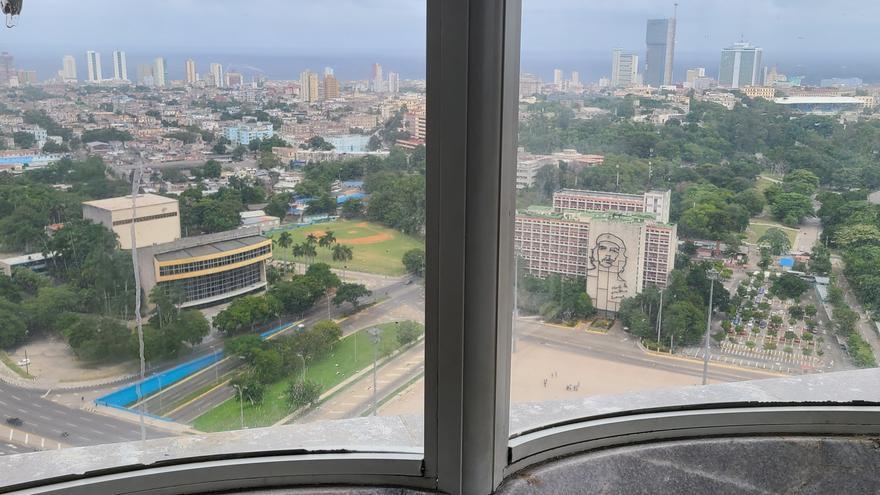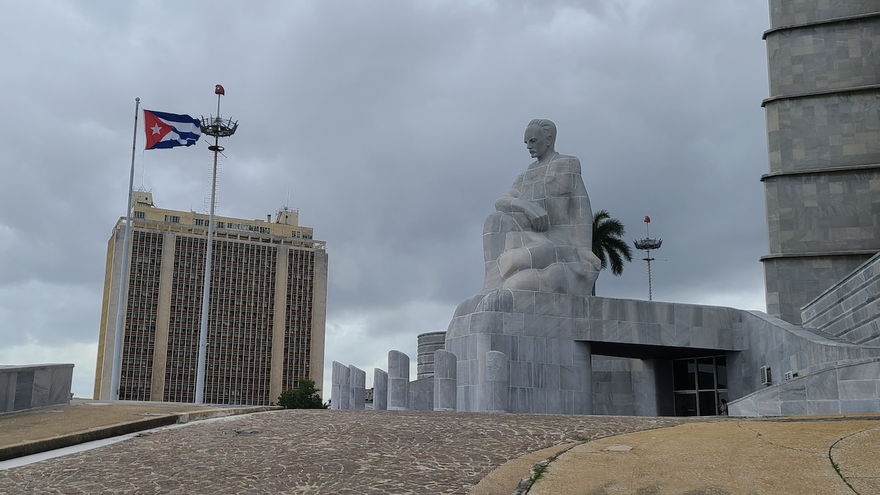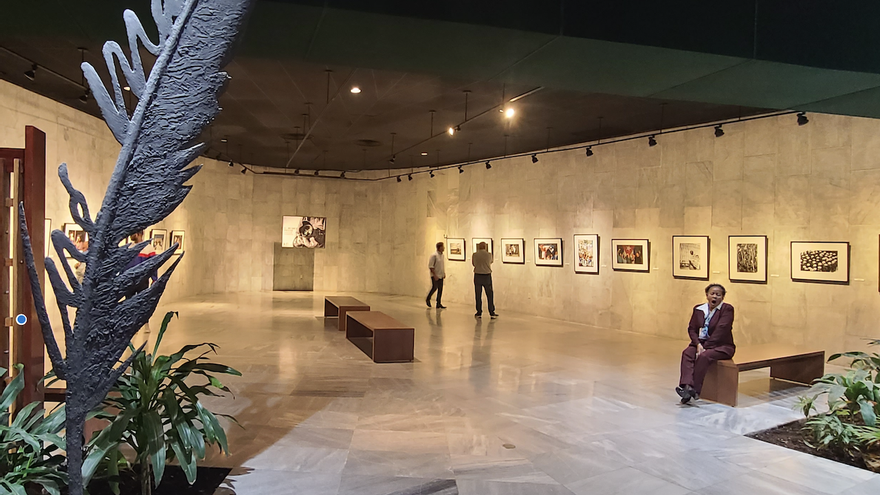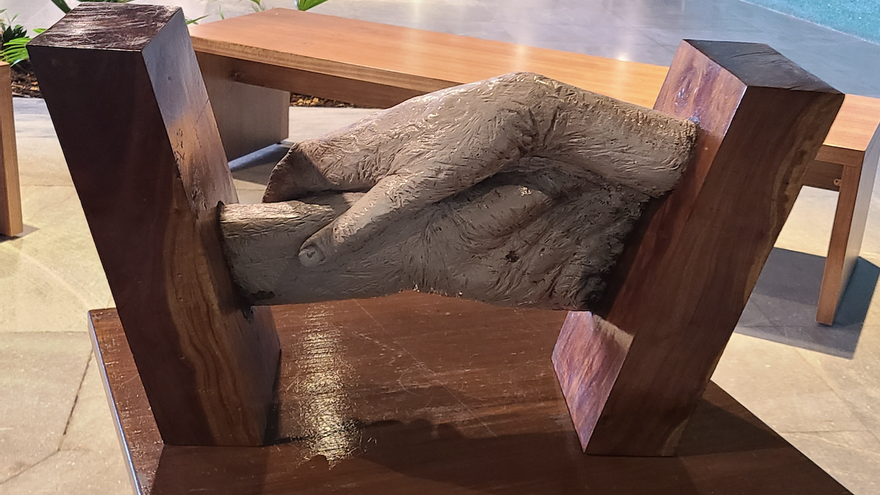
![]() 14ymedio, Pedro Espinosa, Havana, 13 December 2023 — A few years ago a line of taxis and old convertibles regularly filled the esplanade in front of the Plaza of the Revolution’s tower. But the decline in tourism has also led to a decline in visitors to what was once the nerve center of political power on this Island.
14ymedio, Pedro Espinosa, Havana, 13 December 2023 — A few years ago a line of taxis and old convertibles regularly filled the esplanade in front of the Plaza of the Revolution’s tower. But the decline in tourism has also led to a decline in visitors to what was once the nerve center of political power on this Island.
On Wednesday, guards stood watch over the broad rectangle in front of the statue of José Martí that the writer Eliseo Alberto de Diego described as the saddest one that had ever been made. Its faded contour and melancholy pose suggest a sculpture that has melted under the tropical sun while observing the city spread out at its feet.
Adding to the sense of ossification is the stillness. Nothing in the scene moves, not even the uniformed guards. Hours pass before a lone person walks up the ramp towards the José Martí Memorial. The view provides a different vantage point, allowing us to see what most Cubans have only observed from below, when they participated in May Day events or stood listening to a very long speech by Fidel Castro.
The leader known for waving his index finger when shouting into microphones there died in 2016 and the site lost its political importance
But the number of political rallies in the plaza have been decreasing over the years as have visits by foreigners. The leader who used to wave his index finger while shouting into microphones there died in 2016 and the site lost its political importance. The same thing has happened to other official spaces such as the Anti-Imperialist Grandstand and, more recently, La Piragua, the esplanade next to the National Hotel in Vedado. The latter, with its proximity to the sea and location at the foot of a cliff, allows for far more effective security precautions for party leaders.
But despite its decline as a revolutionary symbol, visitors still get the sense they are entering the sancta sanctorum, or peeking into the inner workings of the Cuban regime, when they take the elevator or walk past the marble benches that so often held the posteriors of Communist Party bigwigs. Even though everyone knows it was Fulgencio Batista who built the place, and that before the Revolution it was originially known as Civic Plaza, the site has become an emblem of Castroism.
Motivated by curiosity and the almost desperate public pleas by its caretakers for people to visit the site, the visitor climbs the hill and heads straight to a small ticket office to purchase a ticket to the viewing platform, galleries and temporary exhibitions, which are open, Monday to Saturday, from 9:30 A.M. to 4:00 P.M.
Those in charge of the monument took advantage of the sudden attention from goverment media outlets to point out that entry to the museum is 20 pesos for Cubans. Since currency unification, foreigners can now also pay in the local currency, for which they will need 150 pesos, less than a dollar at the unofficial exchange rate.

After buying a ticket, a guide will explain, upon request, that the tower was built on the highest point of the site, formerly known as Loma de los Catalanes. He will discuss details of the design competition that led to two of the proposals being combined into one and will describe the marble that was transported from the what is now known as the Isle of Youth.
One of the employees, most of whom are women, will provide details, names, figures and dates but will avoid mentioning the slogans about “¡paredón!” — to the wall! — that were chanted in the plaza during fits of collective hysteria demanding the executions of opponents after Castro came to power. Nor will she talk about the unsavory characters, trigger-happy figures or authoritarian leaders who have been invited to appear at the memorial. And she will certainly not allude to the turkey vultures that constant inhabits of the hilltop.
Then, after listening to this speech in which the guide takes the opportunity of to denigrate the former republic and praise Castro, one will be allowed to cross the threshold and enter an odd series of spaces. Laid out in a configuration dictated by the star shape that the tower maintains from its base to its pinnacle, the first thing that stands out are the walls with quotes by the “apostle,” José Martí. And what quotes!
“Unify, that is the word of the world.” And “Silence is the modesty of great characters.” Or the politically incorrect “The people who want to be free shall be free in business.” These are among the seventy-nine musings by Martí that can read in a mural by the Cuban painter and ceramist Enrique Caravia, all of them inscribed in 22-carat gold on a greenish blue background.

Photos, facsimiles of letters and personal objects on display in the galleries provide a snapshot of a man who only lived for forty-two years. Among the large format images on display, a head-to-toe photo of Fidel Castro stands out. A dark snapshot that often puzzles tourists, it shows him holding a Cuban flag on a narrow stretch of beach at Cajobabo that recalls Martí’s landing on that coast in 1895.
The image of Castro, dressed in a khaki uniform and assuming a rigid posture, clashes with the warm civility of Mariano and Leonor’s son, who has accompanied the visitor to the memorial here. Wielding the flag like a spear, the ruler seems to want to lay claim to any space or reference having anything to do with José Martí. By planting a flag, he is signaling that this is also his museum.
It is no surprise that one of the temporary exhibitions on display is titled “Fidel’s Hands.” It includes photos by Alberto Korda and Roberto Chile as well as a painting by Oswaldo Guayasamín in which Castro looks more like a saint in an El Greco painting than a stern tyrant who held power for almost half a century without allowing free elections.
Finally, it is time to go up to the lookout. The guide, always attentive to those who are curious, leads them to a narrow perch with acrylic windows. Up there, where vehicles driving along Rancho Boyeros Avenue look tiny and the Council of State building looks it was designed for the Third Reich, the guide begins to share details about the size of the building: 142 meters tall.

According to urban legends, of which there is no shortage when it comes to this topic, there is a regulation which prohibits the construction of any building in Havana taller than the José Martí Monument. But, at 154 meters, the imposing Tower K, which can clearly be seen from the windows at the top of the monument, makes it clear that this is just a hoax. Or that politics lost out to tourism in the battle over height.
The absence of human presence in the plaza, the imposing buildings and lack of trees is more noticeable from the top. One can make out, in a foreshortened view, the outline of Che Guevara’s face on the gloomy Ministry of Agriculture building, the same portrait that is slyly included in official photos so that he appears in the frame alongside official visitors such as Barack Obama and King Felipe VI of Spain.
The immediate impression one gets is that the entire architectural complex has not aged well. While the world is moving towards more people-friendly public spaces, the center of Cuban power is not a place where people choose to go voluntarily, where friends meet and mothers walk their babies in strollers. The gray marble also gives it a funereal quality that is only reinforced by the completely empty esplanade.
A turkey vulture pervades the space beyond the window. On the other side are scavenger birds drawn to high elevations and tall buildings. One cannot help but see a parallel between the rotting meat they feed on and the decadence of the Cuban system that the Plaza of Revolution represents. The guide doesn’t even glance at the huge bird just outside. Instead, she quickly wraps up her speech and warns visitors that it’s time to head down.
____________
COLLABORATE WITH OUR WORK: The 14ymedio team is committed to practicing serious journalism that reflects Cuba’s reality in all its depth. Thank you for joining us on this long journey. We invite you to continue supporting us by becoming a member of 14ymedio now. Together we can continue transforming journalism in Cuba.
